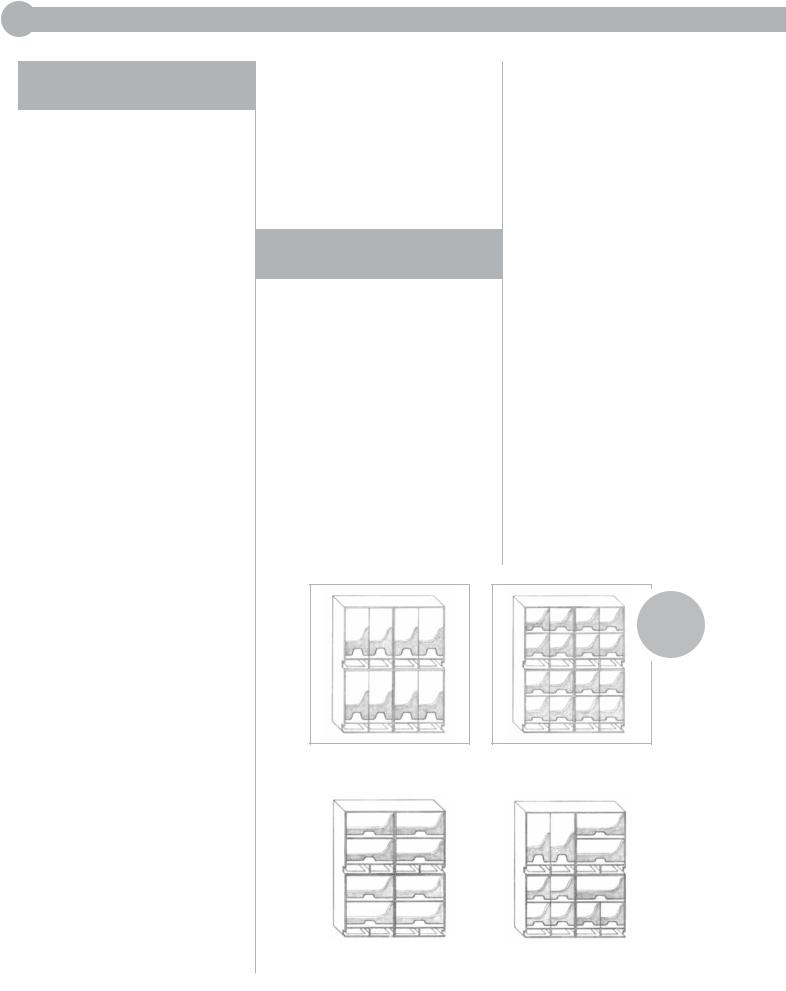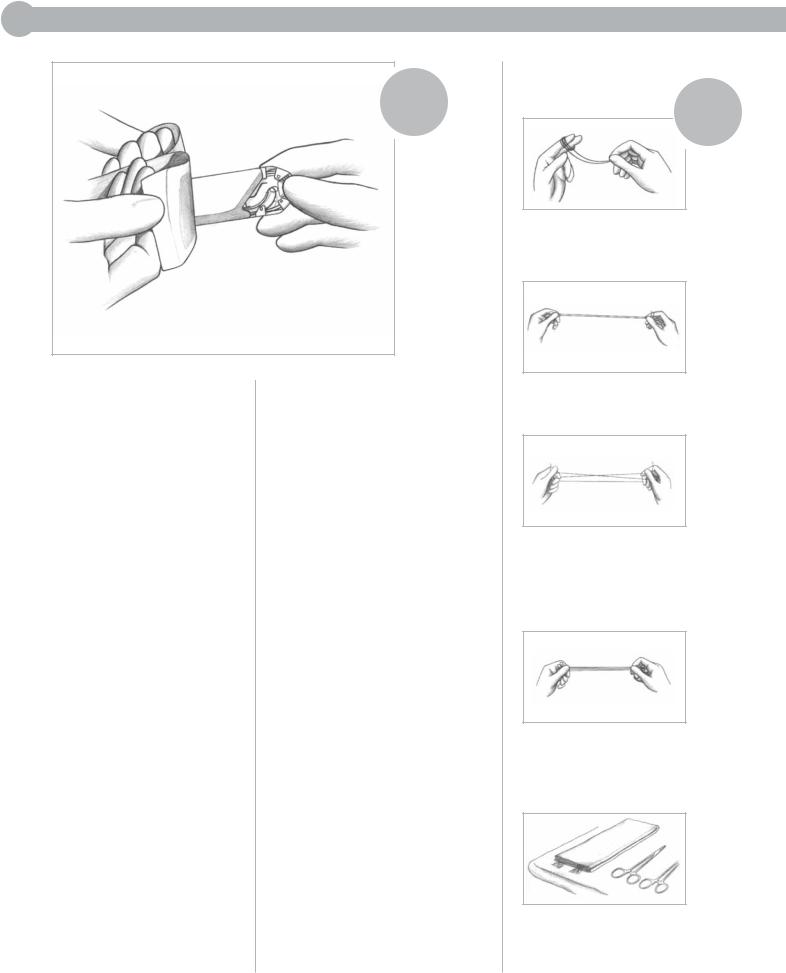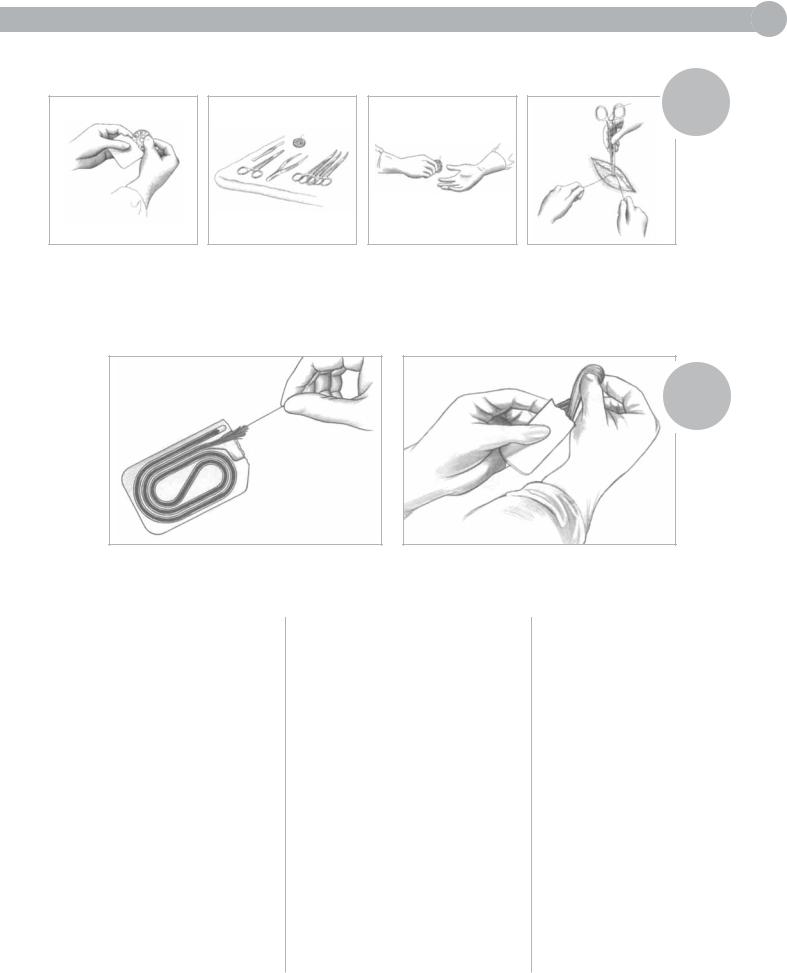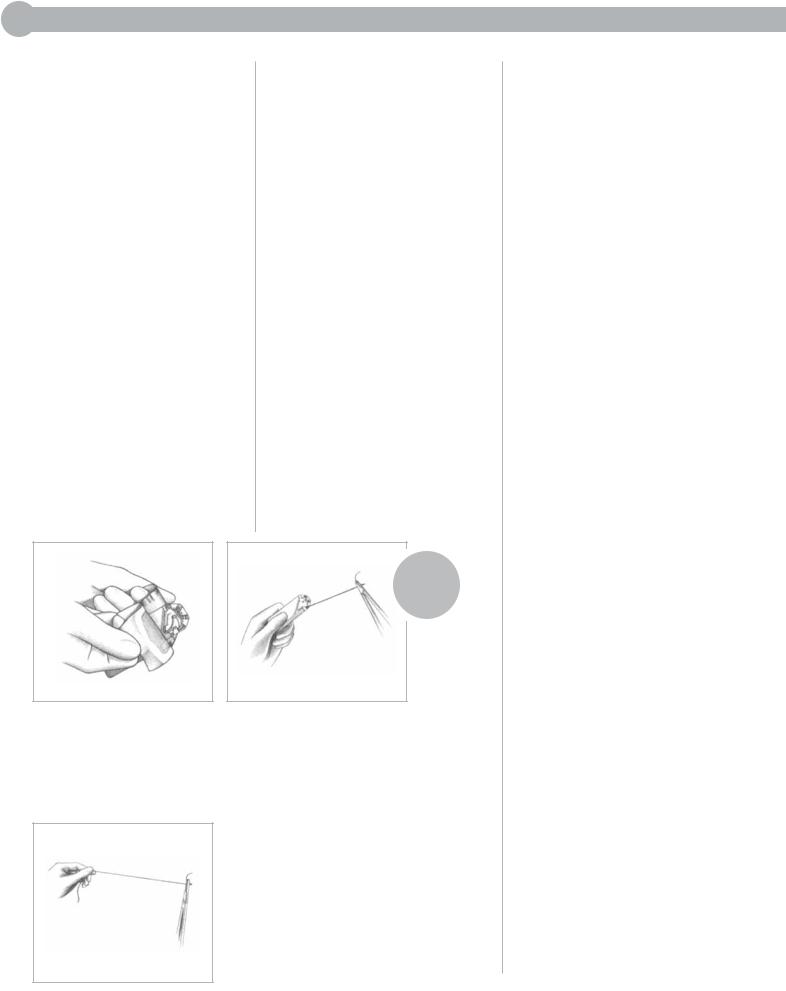
ethicon_wound_closure_manual
.pdf
56 PACKAGING
AN INTEGRAL PART OF THE PRODUCT
The purpose of a package is to protect its contents and provide convenience to the user.
ETHICON, INC., wound closure packaging is an integral part of each product. Over the past half a century, packaging has evolved from glass tubes packed in jars,
to multilayered foil and paper packages, to new materials that reflect concern for both the environment and the individuals who must maintain operative sterility and efficiency. Packaging has kept pace with the technological developments of wound closure products themselves. Several factors have influenced these developments:
Increasing product diversity
Technological advances in packaging materials
Stringent regulatory requirements
To prevent infection in an operative wound, all instruments and supplies that come in contact with the wound must be sterile (free of living microorganisms and spores) including sutures, needles, ligating clips, stapling instruments, adhesive tapes and topical skin adhesives. High standards and criteria are set for all components in the packaging of sterile products:
1.Protect and preserve product stability and sterility from potential deterioration from outside forces such as oxygen, moisture, light, temperature, dust, and vermin.
2.Prevent product damage or microbial contamination in transit and storage.
3.Provide identifiable product information.
4.Permit convenient, safe, and sterile transfer of the product from the package to the sterile field.
5.Meet the functional needs of all members of the surgical team.
RELAY* SUTURE DELIVERY SYSTEM
Most suture materials are packaged and sterilized by the manufacturer. They arrive ready for use in boxes that can be stored until needed. The RELAY Delivery System, developed by ETHICON, INC., with human, clinical, and environmental factors in mind, stores and delivers sutures in a time-efficient manner and reduces unnecessary handling to access sutures. The system also provides control over suture storage, usage, inventory rotation, needle counting, and cost containment.
The RELAY Delivery System consists of 3 basic, interrelated components: modular suture storage racks, dispenser boxes, and primary packets.
MODULAR STORAGE RACKS
The modular storage racks are designed for maximum convenience and versatility to meet the individual needs of a particular specialty, nurse, surgeon, or department. Modules can be easily assembled
to accommodate both vertical and horizontal suture dispenser boxes. Any number of modules can be fastened together to meet both small and large storage needs. Once assembled, the racks may be used on shelves, mounted on walls, placed on mobile carts, or connected to IV poles. Racks can also be fitted with a rotating base for more convenient access, as well as with a handle for easy carrying. Each module has a built-in
FIGURE 1
ETHICON
MODULAR
STORAGE
RACKS
Full-vertical boxes |
Half-vertical boxes |
|
|
|
|
|
|
|
Horizontal boxes |
Combination of boxes |

inventory control area to facilitate restocking. This feature enables unused suture packets to be systematically fed back into the proper rotational flow without mixing lots within the boxes. Sutures may be grouped within the modular system by material type or size, or by use (ie, general closure, gastrointestinal surgery, plastic surgery).
DISPENSER BOXES
Gravity-fed dispenser boxes dispense suture packets from the opening at the bottom of the box. The opening can accommodate the removal of several suture packets at one time.
All ETHICON, INC., dispenser boxes are made of recyclable paper and printed with either water or soy-based inks. Each box provides clear product identification through streamlined graphics, product
color coding, bold label copy, bar coding and descriptive symbols. The information required for quick reference and easy selection of suture materials is highlighted in
a logical sequence. The 3 most important criteria necessary for proper identification and suture selection are:
1.Suture size
2.Suture material
3.Type and size of needle
Other important product information found on all suture boxes includes:
1.Surgical application
2.Product code number
3.Suture length and color
4.Metric diameter equivalent of suture size and length
5.Shape and quantity of needles (singleor double-armed, shown
CHAPTER 4 57
by silhouette)
6.Needle point geometry
7.Lot number
8.Expiration date
A package insert with detailed information about the suture material is inserted in every dispenser box. Users should be familiar with this information as it contains FDA-approved indications, contraindications, and all appropriate warnings and precautionary statements for each product.
Dispenser boxes should be restocked when the last few suture packets appear in the box opening, before the box is completely empty. The unused packets from the previous box should be used before a new dispenser box is opened. This will help to avoid mixing lot numbers and ensure proper stock rotation. ETHICON, INC., advocates rotation of the entire dispenser box. In addition to ensuring the use of the oldest suture materials first, this helps to maintain a fresh stock of dispenser boxes.
Most dispenser boxes contain three dozen suture packets. Others may contain 1- or 2-dozen packets. The product code number suffix and a statement on the box indicate the quantity of suture packets in the box (product code suffix G = 1 dozen, D = 1 dozen, T = 2 dozen, H = 3 dozen). The
dispenser boxes are held securely for easy dispensing by firmly pushing the box into a "lock" in the back of the rack module.
PRIMARY PACKETS
Individual sutures and multiple suture strands are supplied sterile within a primary packet. The exterior
surfaces of the overwrap are not sterile. ETHICON, INC., packaging is designed to permit and easy opening in one peelable motion. The single layer
of primary packaging is made of either foil or coated Tyvek® on side heat-sealed to polyethylene on the other. Absorbable sutures always encased in foil to provide safe and durable moisture barrier and to withstand sterilization in the manufacturing process. Most nonabsorbable sutures are
in coated Tyvek® overwraps.
In a continuous effort to be more environmentally conscious, ETHICON, INC., has chosen materials in the manufacture of primary packets that generate minimal negative impact to the environment upon incineration disposal. Furthermore, wherever possible, the number of primary packaging layers has been
by as much as 50 percent, thus reducing the volume of environmental waste per OR procedure.
Each primary packet provides critical product information and the same color-coding as its dispenser box. The packet also identifies the product code material, size, needle type, and number of needles per packet to simplify needle counts.
Primary packets of suture may contain sutures in 1 of 5
1.Standard lengths of nonmaterial: 54 inches (135 cm) absorbable or 60 inches (150 of nonabsorbable suture, may be cut in half, third, or quarter lengths for ligating or threading.

58 PACKAGING
|
|
|
|
|
|
|
|
ABSORBABLE SUTURE |
LAYERS |
|
|
|
|
|
|
|
|
|
||
|
|
|
|
|
TABLE |
|
|
Surgical Gut Suture |
Tyvek overwrap, foil |
|
|
||
|
|
package containing |
|
1 |
|
|
|
|
RELAY Suture Delivery |
|
|
|
|
|
Coated VICRYL RAPIDE Suture |
Tyvek overwrap, foil primary package, |
|
|
|
|
|
|
paper folder |
|
|
|
|
|
|
|
|
|
|
|
|
MONOCRYL Suture |
Peelable foil overwrap, 1-step |
|
|
|
|
|
|
RELAY tray |
|
|
|
|
|
|
|
|
|
|
|
|
Coated VICRYL Plus |
Peelable foil overwrap, 1-step |
|
|
|
|
|
Antibacterial Suture |
RELAY tray |
|
|
|
|
|
|
|
|
|
|
|
|
Coated VICRYL |
Peelable foil overwrap, 1-step |
|
|
|
|
|
(polyglactin 910) Suture |
RELAY tray |
|
|
|
|
|
|
|
|
|
|
|
|
PDS II Suture |
Peelable foil overwrap, 1-step |
|
|
|
|
|
|
RELAY tray |
|
|
|
|
|
|
|
|
|
|
|
|
NONABSORBABLE SUTURE |
LAYERS |
|
|
|
|
|
|
|
|
|
|
|
|
PERMA-HAND Silk Suture |
Tyvek overwrap, 1-step RELAY tray |
|
|
|
|
|
Stainless Steel Suture |
Tyvek overwrap, paper folder |
|
|
|
|
|
|
|
|
|
|
|
|
ETHILON Suture |
Peelable foil overwrap, 1-step |
|
|
|
|
|
|
RELAY tray |
|
|
|
|
|
|
|
|
|
|
|
|
NUROLON Suture |
Tyvek overwrap, 1-step RELAY tray |
|
|
|
|
|
|
|
|
|
|
|
|
MERSILENE* Suture |
Tyvek overwrap, 1-step RELAY tray |
|
|
|
|
|
|
|
|
|
|
|
|
ETHIBOND EXCEL Suture |
Tyvek overwrap, 1-step RELAY tray |
|
|
|
|
|
|
|
|
|
|
|
|
PROLENE Suture |
Tyvek overwrap, 1-step RELAY tray |
|
|
|
|
|
|
|
|
|
|
|
|
PRONOVA Suture |
Tyvek overwrap, 1-step RELAY tray |
|
|
|
|
|
|
|
|
|
|
|
Tyvek is a registered trademark of E.I. du Pont de Nemours and Company
FIGURE 2
METHOD FOR PREPARING 1-STEP RELAY PACKAGE SUTURES
Arm the needle directly from the 1-step RELAY tray and deliver the single suture to the surgeon.
2.SUTUPAK* Pre-cut Sterile Suture is non-needled material for ligating or threading. These lengths may be supplied in a multistrand labyrinth packet or in a folder packet, both of which are designed to deliver one strand at a time. SUTUPAK Sutures may be removed from the packet and placed in the suture book.
3.One single strand of material with singleor double-armed swaged needle(s). Needles for 1-step RELAY Packaging, microsurgery, and some ophthalmic needles are secured in a "needle park." The needle park is designed to provide a standard location for, and easy access to, the needle. All other needles are protected within an inner
folder or other specific channel within a paper folder.
Most single strand needled sutures are sealed in convenient 1-step RELAY Delivery Packaging. 1-step RELAY Packaging allow the needle to be armed in the needleholder from any angle without touching the needle. This increases the safety of handling needles intraoperatively. If it is preferred to locate the needle by hand, this can be accomplished with the 1-step RELAY Packaging by pushing up the flap behind the needle park, thereby elevating the needle so it can be grasped by hand.
4.Multiple suture strands, either swaged to a single needle or double-armed. This type is appropriate for procedures requiring numerous interrupted sutures of the same type. It saves valuable operative time by

enabling the surgeon to use one suture while the next is being armed—without delay of opening packets or threading needles.
Multistrand packets are labeled with the symbol MS/ that denotes multiple strands/number of strands of surgical needles per packet. Multistrand packets may contain 3 to 10 swaged sutures. The inner folder for these products is white.
All packets containing CONTROL RELEASE Needle Sutures have multiple strands (8, 5, 4, 3, or 1) and are designated CR/8, CR/5, CR/4, CR/3, or CR/1. CONTROL RELEASE Sutures may be available in foil or Tyvek overwrap packets for single strand delivery. The single strand delivery folder is used for some Coated VICRYL Sutures, MONOCRYL Sutures,
PDS II (polydioxanone) Sutures, ETHIBOND EXCEL Sutures, NUROLON Sutures, MERSILENE Sutures, and PERMA-HAND Sutures. The suture material straightens as it is delivered from the folder. Each suture may be delivered to the surgeon individually from the opening packet or removed from the folder and placed in the suture book. The inner folder for these products is either red with a black C/R symbol or white with red lettering.
The safety organizer tray is used for Coated VICRYL Sutures, MONOCRYL Sutures,
PDS II Sutures, ETHIBOND EXCEL Sutures, PERMAHAND Sutures, NUROLON
CHAPTER 4 59
Sutures, MERSILENE sutures, and surgical gut sutures. The safety organizer tray allows for single strand arming and dispensing. The needles are situated in individually numbered needle parks and may be armed and dispensed with little or no hand-to-needle contact.
5.Ligating material used as either single strand (free or freehand) ties, or as continuous ties unwound from a reel or other device. The length of single strand ties is determined by the depth of the wound. In subcutaneous tissue, quarter lengths (approximately 14 inches) are usually long enough for ligating. Single strand ligating material is available in pre-cut lengths or 18-, 24-, and 30-inch strands.
Many surgeons prefer continuous ties. Some prefer LIGAPAK Ligature, which is supplied on disc like plastic radiopaque dispensing reels that are color coded by material. The size of the ligature material is indicated by the number of holes visible on the side of the reel (eg, 3 holes= 3-0 suture). The reel is held in the palm of the hand as blood vessels are ligated. Other surgeons may prefer the ligating material rewound onto a rubber reel, gauze sponge, metal bobbin, or other device.
The number of packets of ligating material required to tie off subcutaneous vessels (bleeders) will vary with patient size and age, the amount of bleeding, the type of operation, the length of the incision,
and the surgical technique.
An abdominal incision 8 to 12 inches long might require 1 to 3 packets to ligate the subcutaneous blood vessels.
All suture material is packaged dry with the exception of surgical gut and pliabilized ETHILON Sutures. Natural absorbable suture materials are packaged with a small amount of sterile fluid, usually alcohol with water, to maintain pliability. They should
therefore be opened over a basin to prevent any solution from spilling onto the sterile field.
All needles should be counted after packets of swaged sutures are opened, according to established hospital procedure. The packets should be retained to facilitate verification of the final needle count after the surgical procedure.
E-PACK* PROCEDURE KIT
The E-PACK procedure kit contains numerous sutures and other products for a specific procedure, surgeon, or surgical specialty. The packaging concept saves valuable time in the OR by eliminating the need to open and coordinate multiple individual suture packages. The E-PACK procedure kit is also an effective means of reducing inventory levels of individual product codes, and providing a record for determining the suture
costs associated with a given surgical procedure.

60 PACKAGING
The suture packages are secured in an organizer sleeve to facilitate sterile transfer to the sterile field.
The procedure kit label provides all the pertinent information regarding the number and types of needles, as well as sizes and types of suture.
Suture quantities are listed on the label, making it easy to quickly determine how many needles have been used and thus simplifying needle accountability at the end of the procedure. The organizer sleeve is delivered in a Tyvek pouch.
EXPIRATION DATE
The expiration date of a product is determined by product stability studies. ETHICON, INC., suture products have an expiration date stamped on each dispenser box and primary packet to indicate the known shelf life of the material, provided the physical integrity of the package is maintained. Tests conducted by ETHICON, INC., show conclusively that synthetic absorbable suture products such as Coated VICRYL Suture and
PDS II Suture continue to meet all product requirements even at 5 years of storage.
The RELAY Delivery System is designed as a "first-in, first-out" inventory control system. Dispenser boxes are rotated, permitting the oldest sutures to be used first. The expiration date stamped on the outside of each box and every packet clearly indicates the month and year of product expiration.
SUTURE STERILIZATION
Sutures sterilized by ETHICON, INC., are either irradiated with cobalt 60 or exposed to ethylene oxide gas. Both processes alter proteins, enzymes, and other cellular components to the extent that microorganisms are unable to survive or cause infection. Irradiation and ethylene oxide gas are considered cold sterilization processes because radiation sterilizes at room temperature and ethylene oxide gas sterilizes at much lower temperatures than other sterilization methods such as dry heat or steam under pressure.
Irradiation sterilization exposes products to ionizing radiation— either beta rays produced by high energy electron accelerators or gamma rays from radioisotopes— until absorbed in appropriate sterilizing dose. ETHICON, INC., was a pioneer in both beta and gamma irradiation and routinely sterilizes products with cobalt
60 which emits gamma rays. Cobalt 60 irradiation is the simplest of all sterilization processes.
Some suture materials cannot withstand the effects of irradiation sterilization, becoming unusable. Instead, they are gas sterilized. Gas sterilization uses ethylene oxide gas.
As an environmental measure, ETHICON, INC., replaced chlorofluorocarbons (CFCs) with more environmentally friendly compounds in all gas sterilization processes. The combination of ethylene oxide gas concentration, temperature, humidity, and exposure time must be carefully controlled to ensure reliable sterilization.
WARNING: Surgical sutures are labeled as disposable, single-use medical devices. Suture products manufactured by ETHICON, INC., are provided in easy-to-use packages designed to maintain the stability and sterility of the suture and needle materials. The component layers of packaging materials do not permit exposure to high temperatures or extremes of pressure without affecting package and product integrity. For this reason, all sterile products manufactured by ETHICON, INC., are clearly labeled, "DO NOT RESTERILIZE."
Manufacturers cannot be held responsible for the quality, effectiveness, or integrity of suture materials resterilized in the hospital, office, or by outside vendors. Therefore, if customers utilize the services of a sterilization reprocessor for suture, ETHICON, INC., will disclaim any responsibility for sterilization and/or other product failures resulting from the resterilization process. The practice of resterilization is not recommended except for ETHI-PACK Sutures and spools or cardreels of nonabsorbable materials supplied nonsterile.

ANTICIPATING SUTURE NEEDS
Today's healthcare environment dictates that hospitals continue to maintain quality standards while lowering costs to remain financially viable. Through total quality management initiatives, many hospitals have identified material use as an opportunity to lower cost. To increase the efficiency of suture utilization during a surgical procedure, it is important to determine and anticipate the surgeon's needs more precisely. For this reason, a file system of preference cards for each surgeon
on staff is usually maintained in the operating suite. The cards contain such information as the surgeon's "suture routine," suture materials, sizes, needles, and/or product
code numbers customarily used in specific procedures.
Becoming more aware of each surgeon's routine through good communication and regularly updated preference cards can help reduce preparation time, minimize waste, and assure cost effectiveness. Prior to dispensing suture packets, the circulating nurse should have a brief discussion with the surgeon to ascertain whether a change in suture routine is anticipated due to a specific patient's needs.
While it is difficult to say precisely how many suture packets are enough, 3 major factors should be considered in deciding how many packets to open:
1.Fewer packets will be needed if products with multiple strands of suture material are used.
CHAPTER 4 61
2.Opening sufficient suture packets to prevent prolonging operative time and causing surgeon inconvenience.
3.Leftover suture on the surgical field must be discarded. Therefore, opening too many suture packets should be avoided to reduce waste and to lower cost.
Although it is important to be prepared to answer requests at a moment's notice, it is not necessary to overload the table with sutures. The introduction of single-layer peelable packaging, such as 1-step RELAY Packaging, helps encourage less handling to access the suture, enhancing quick delivery of suture materials to the surgeon in the sterile field. Unexpected suture needs can also be obtained rapidly from the storage racks.
STERILE TRANSFER OF SUTURE PACKETS
At some point, suture packets must cross the sterile barrier—the invisible line of demarcation between the sterile and the nonsterile. In all settings (eg, operating room, delivery room, emergency department, or physician's office), the individual who removes
the nonsterile overwrap must remember these 3 points about sterile transfer:
1.Outer surfaces of the overwrap are not sterile and may be handled with nonsterile hands.
2.The sterile inner packet or tray must be transferred to the sterile field without being touched or contacting any nonsterile object or surface.
3.Nonsterile hands over the sterile field violate aseptic technique.
There are 2 methods commonly used for achieving sterile transfer of suture packets: handing-off the sterile inner 1-step RELAY tray directly to the scrub person or "flipping" the inner contents of the
primary packet onto the sterile field. Regardless of the aseptic technique performed, all items introduced onto the sterile field should be opened, dispensed, and transferred by methods that maintain product sterility and integrity. AORN Guidelines recommend the "hand-off" method, since items tossed or flipped have a greater potential to roll off the edge of the sterile field, causing contamination or other items to be displaced.
METHOD I: STERILE TRANSFER TO THE SCRUB PERSON
Grasp the 2 flaps of the peelable overwrap between the knuckles of the thumbs and forefingers. With a rolling-outward motion, peel the flaps apart to approximately one third of the way down the sealed edges. Keeping pressure between the knuckles for control, offer the sterile inner packet or tray to the scrub person, who takes it with a gloved hand or sterile instrument. Care must be taken to avoid contact with the nonsterile overwrap as the packet or tray
is withdrawn.
This method must be used to remove paper folder packets of surgical steel and PROLENE Sutures from long straight overwraps, and to remove the organizer sleeves from E-PACK procedure kits. It should also be used for transfer of flexible,

62 PACKAGING
FIGURE 3
STERILE
TRANSFER
TO THE
SCRUB
PERSON
transparent packets microsurgery and products.
II: STERILE TRANSFER TO STERILE FIELD
is a rapid and efficient of ejecting sterile product its overwrap onto the sterile
without contacting the outer packet or reaching
the field. However, skill must acquired to ensure its effective
. The circulating nurse must near enough to the sterile to project the suture packet
tray onto it, but not too close risk contaminating the table
touching it or extending hands over it. To
this, grasp the flaps overwrap as described in
I and peel the flaps apart the same rolling-outward
. The sterile packet or tray onto the sterile table
overwrap is completely apart.
DO NOT attempt to prothe inner folder of long straight
onto the sterile table.
Instead, present them to the scrub person as outlined in Method I.
SUTURE PREPARATION
IN THE STERILE FIELD
Suture preparation may be more confusing than virtually any other aspect of case preparation. Familiarity and understanding of the sequence in which tissue layers are handled by the surgeon will help to eliminate this confusion. (See the Suturing Section, Chapter 2.)
Once the suture packets are opened and prepared according to the surgeon's preference card, sutures can be organized in the sequence in which the surgeon will use them. Ligatures (ties) are often used first in subcutaneous tissue shortly after the incision is made, unless ligating clips or an electrosurgical cautery device is used to coagulate severed blood vessels.
After the ligating materials have been prepared, the suturing (sewing) materials can be prepared in the same manner. Preparing large amounts of suture material in advance should be avoided. For
PREPARATION OF STANDARD LENGTH
LIGATURE STRANDS
FIGURE 4
1.Prepare cut lengths of ligature material, coil around fingers of left hand, grasp free ends with right hand, and unwind to full length.
2.Maintain loop in left hand and
2 free ends in right hand. Gently pull the strand to straighten.
3. To make 1/3 lengths: Pass 1 free
end of strand from right to left hand.
Simultaneously catch a loop around third finger of right hand. Make strands equal in thirds and cut the loops with scissors.
4.To make 1/4 lengths: Pass both free ends from right to left hand. Simultaneously catch a double loop around third finger of right hand.
Cut the loops.
5.Place packets or strands in suture book (folded towel)—or under Mayo tray—with ends extended far enough to permit rapid extraction.

CHAPTER 4 63
PREPARATION OF CONTINUOUS TIES ON A LIGAPAK DISPENSING REEL
FIGURE 5
1.Open the packet containing the appropriate material on a reel. Transfer the inner contents of the primary packet to the sterile field using aseptic technique.
2.Extend the strand end slightly for easy grasping. Place reel conviently on the Mayo tray.
3.Hand reel to surgeon as needed, being certain that the end of the ligating material is free to grasp.
4.Surgeon holds reel in palm, feeds strand between fingers, and places around tip of hemostat.
1.Remove 1 pre-cut length from nonabsorbable suture at a time from the labyrinth packet as it is needed by the surgeon.
FIGURE 6
PEPARATION
OF PRE-CUT
SUTURES
FOR TIES OR
LIGATURE
SUTURES
2.Extract pre-cut strands of SUTUPAK Suture. Straighten surgical gut with a gentle pull. Place strands in the suture book or under Mayo tray.
example, if the surgeon opens the peritoneum (the lining of the abdominal cavity) and discovers disease or a condition that alters plans for the surgical procedure and anticipated use of sutures, opened packets would be wasted. At closure following abdominal surgery, remembering the letters PFS (peritoneum, fascia, skin) will be helpful for organizing sutures.
By watching the progress of the procedure closely, listening to comments between the surgeon and assistants, and evaluating the situation; suture needs can
be anticipated. Free moments can be used to prepare sufficient suture
material to stay one step ahead of the surgeon. The goal should be to have no unused strands at the end of the procedure.
Ligature material which remains toward the end of the procedure may be the same material and size specified by the surgeon for sutures in the subcutaneous layer of wound closure. In this case, the remaining ligating material should be used rather than opening an additional suture packet.
If the surgeon requires "only one more suture," and strands of suitable material remain which are shorter than those prepared
originally, do not be reluctant to ask the surgeon if one of the strands will serve the purpose before opening a new packet. Most surgeons are cooperative in efforts to conserve valuable
SUTURE HANDLING TECHNIQUE
During the first postoperative the patient's wound has little or
strength. The sutures or mechanical devices must bear the responsibility of holding the tissues together during this period. They can only perform this function reliably if quality and integrity of the
closure materials are preserved

64 PACKAGING
handling and preparation to use. It is therefore essential
everyone who will handle the materials to understand procedure to preserve tensile strength.
general, avoid crushing or sutures with surgical
such as needleholders forceps, except as necessary
the free end of a suture an instrument tie. There
also specific procedures to to preserve suture tensile
which depend upon
the material is absorbable nonabsorbable. The following
the most important for each member of the
team to remember and
in handling suture materials surgical needles.
FOR THE CIRCULATING NURSE
1.Consult the surgeon's preference card for suture routine.
2.Check the label on the dispenser box for type and size of suture material and needle(s). Note the number of strands per packet. Fewer packets will be needed if multistrand or CONTROL RELEASE Needle Sutures are used.
3.Estimate suture requirements accurately and dispense only the type and number of sutures required for the procedure.
4.Read the label on the primary packet or overwrap before using to avoid opening the wrong packet.
5.Use aseptic technique when peeling the overwrap. Transfer the inner contents of the primary packet to the sterile field by offering it to the scrub person or
FIGURE 7
1.With a rolling-outward motion, peel the flaps apart to approximately one third the way down the sealed edges. Keeping pressure beween the knuckles for control, offer the sterile inner RELAY package to the scrub person.
2.Clamp the needleholder approximately one third to one half of the distance from the swage area to the needle point. Do not clamp the swaged area. Gently pull the suture to the right in a straight line.
3.Additional suture straightening should be minimal. If the strand must be straightened, hold the armed needleholder and gently pull the strand, making certain not to disarm the needle from the suture.
by projecting (flipping) it onto the sterile table, avoiding contamination.
6.To open long straight packets, peel overwrap down 6 to 8 inches and present to the scrub person. Do not attempt to project the inner folder of long straight packets onto the sterile table.
7.Maintain an adequate supply of the most frequently used sutures readily accessible.
8.Rotate stock using the "first-in, first-out" rule to avoid expiration of dated products and keep inventories current.
9.Suture packets identify the number of needles per packet to simplify needle counts. Retain this information during the procedure and/or until final needle counts are completed.
10.Count needles with the scrub person, per hospital procedure.
FOR THE SCRUB PERSON
1.If appropriate, remove the inner 1-step RELAY package or folder containing suture materials from the primary packet being offered from the circulating nurse.
2.Hold the 1-step RELAY package or folder in gloved hand and arm the needle using the "no-touch" technique. Gently dispense the suture.
3.Leave pre-cut suture lengths in labyrinth packet on the Mayo tray. Strands can then be removed one at a time as needed.
4.Surgical gut and collagen sutures for ophthalmic use must first be rinsed briefly in tepid water to avoid irritating sensitive tissues.

If the surgeon prefers to use sutures wet, dip only momentarily. Do not soak. Silk sutures should be used dry.
5.Do not pull or stretch surgical gut or collagen. Excessive handling with rubber gloves can weaken and fray these sutures.
6.Count needles with the circulating nurse, per hospital procedure.
7.Hold single strands taut for surgeon to grasp and use as a freehand tie.
8.Do not pull on needles to straighten as this may cause premature separation of CONTROL RELEASE Needle Suture.
9.Always protect the needle to prevent dulling points and cutting edges. Clamp the needleholder forward of the swaged area, approximately one third to one half the distance from the swage to the point.
10.Microsurgery sutures and needles are so fine that they may be difficult to see and handle. They are packaged with the needles parked in foam to protect delicate points and edges. The needles may be armed directly from the foam needle park. If the microsurgeon prefers to arm the needle, the removable orange colored tab may be used to transport the needle into the microscopic field.
11.Handle all sutures and needles as little as possible. Sutures should be handled without using instruments unless absolutely necessary. Clamping instruments
CHAPTER 4 65
on strands can crush, cut, and weaken them.
12.Cut sutures only with suture scissors. Cut surgical steel with wire scissors.
13.When requesting additional suture material from the circulating nurse, estimate usage as accurately as possible to avoid waste.
FOR THE SURGEON
1.Avoid damage to the suture strand when handling. This is particularly critical when handling fine sizes of monofilament material. Touch strands only with gloved hand or closed blunt instrument. Do not crush or crimp sutures with instruments, such as needleholders or forceps, except when grasping the free end of the suture during an instrument tie.
2.Clamp a rubber shod hemostat onto the suture to anchor the free needle on a double-armed strand until the second needle is used. Never clamp the portion of suture that will be incorporated into the closure or the knot.
3.Use a closed needleholder or nerve hook to distribute tension along a continuous suture line. Be careful not to damage the suture.
4.Use knot tying techniques that are appropriate for the suture material being used.
